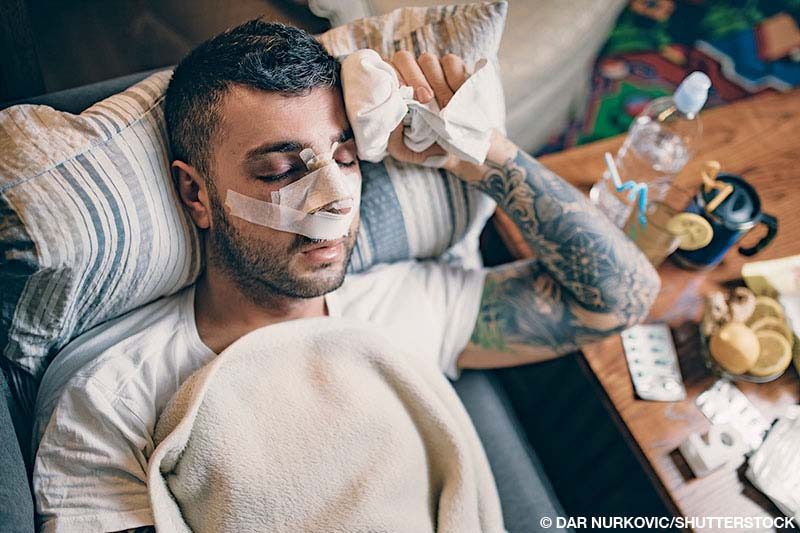DAN medical information specialists and researchers answer your dive medicine questions.
I am 60 years old and had a thrombotic stroke two years ago. Surgery on my carotid artery restored circulation, but I have left arm paralysis and diminished movement in my left leg, and I need a cane to walk. My doctor says I am unlikely to have a repeat stroke, and I currently am not taking any medications. Will I be able to dive again?
A cerebral vascular accident, or stroke, occurs in two ways: hemorrhagic (bleeding) or thrombotic (clot). Both forms affect oxygen and blood flow to the brain. Lasting deficits are common after a stroke and may affect speech, strength and movement. For a thrombotic stroke, a thrombolytic medication such as a tissue plasminogen activator (tPA) can break up the clot and should restore oxygen and blood flow. The unfortunate drawback to this drug is that it must be administered within hours after the onset of symptoms.
Paralysis is not uncommon following a stroke. A doctor should evaluate your level of impairment and what effect it may have on your diving. Inability to use your arms can make it difficult to work with your gear, such as adjusting your buoyancy compensator, clearing your mask or reaching a backup regulator. If the deficit affects your legs, it may be difficult to swim, kick, move with gear on while on a wet boat deck or rocky shore entry, or swim against a current. A physical deficit may also affect your ability to respond to an emergency, making it difficult to self-rescue or rescue a buddy. Residual spasticity can make some activities particularly difficult and exhausting.
Carefully weigh your return to diving, and assess the risk versus reward. Your doctor should determine and address the reason for your stroke. No studies are available that address if the areas of your brain damaged by your stroke will be more susceptible to decompression illness (DCI). Even a mild neurologic DCI incident could have severe consequences and affect the degree of function you achieved through rehabilitation.
If you decide to dive, we suggest that you seek a detailed ongoing assessment and approval from your treating physician. This process should include a complete dive physical and a neurological evaluation that includes the strength and weakness of major muscle groups and the degree of cerebral injury as well as an assessment and comparison of the left side and right side of your body. This evaluation will help avoid diagnostic confusion in the event of postdive problems. The treatment for stroke and DCI is very different, so the correct diagnosis is vital to guide you to the appropriate treatment facility.
Lasting mobility and movement limitations may require you to have further training with specially trained dive buddies. Agencies such as Diveheart (diveheart.org), the Handicapped Scuba Association (hsascuba.com) and others specialize in helping divers with limited mobility to enjoy the underwater world.
— Robert Soncini, NR-P, DMT

I have a rhinoplasty surgery scheduled to repair a deviated septum. What can I expect
for returning to diving after the procedure?
There are two types of rhinoplasty (commonly known as a nose job): cosmetic and reconstructive. Cosmetic rhinoplasty seeks to improve the nose’s appearance and is generally less invasive than reconstructive surgery. Reconstructive rhinoplasty restores the form and function of the nose and corrects traumatic nasal injuries. A reconstructive procedure also treats congenital nose defects and deformities and breathing problems from a deviated septum or other nasal abnormality.
The average healing time before returning to diving after cosmetic rhinoplasty is about two months and about three months for reconstructive rhinoplasty, provided there are no complications. Your surgeon can give you an exact date based on how well the surgery goes and how well you heal. Discuss with your surgeon issues such as equalizing the middle ear and sinuses, whether Valsalva techniques are permitted and the impact of wearing a mask.
Once your surgeon releases you to return to diving, start with several short, shallow dives in a controlled environment such as a pool to see if you have any problems equalizing. Using scuba isn’t necessary; freediving is enough to determine if your ears or sinuses will give you any problems after the surgery. If the initial trial dives go well, further diving shouldn’t be an issue. Be prudent about your diving behavior early in your return — don’t plan your first dive trip after surgery to a remote location or where you are unsure of access to good medical care.
Your equalization technique may change depending on how well you’re able to equalize. If you prefer the Valsalva maneuver, consider using a different technique in the beginning to avoid pinching a nose that’s just been reconstructed. Many DAN members have reported decreased problems equalizing after various types of sinus surgery.
If you have any difficulty equalizing the first time back in the pool, your sinuses may not be ready to withstand the pressures associated with diving, so allow yourself additional healing time.
— Lana P. Sorrell, MBA, EMT, DMT

I have sleep apnea and will be having an Inspire device implanted to help correct this condition. Is there anything I should be concerned about regarding its pressure rating or any other potential complications?
Sleep apnea is a serious medical condition that affects many adults. The most common type is obstructive, which occurs when the muscles that support the soft palate relax, allowing the airway to narrow or even close. Your body’s oxygen level drops, and your brain briefly awakens you, so you open your airway to breathe. This short instance may happen many times in a night, and it is often so brief you are not aware of it. This temporary interruption is why you feel tired throughout the day, even though it seems you had a proper night’s sleep.
Many adults sleep using a continuous positive airway pressure (CPAP) machine to help keep open the airway for a full night’s rest. A CPAP machine’s drawbacks are that it is often bulky, requires a mask seal and needs regular maintenance.
Inspire is a device that is implanted under the skin near the right collarbone. Two guide wires run from the device: One lead connects to the hypoglossal nerve near the tongue’s base, and the other extends to an area between the ribs on the right chest to sense breathing. When it senses breathing, a small impulse goes to the tongue to move it forward and open the airway. A remote control can turn on and off the device.
Following implantation, give the surgical sites ample time to heal before undertaking dive activities. Water immersion too soon after surgery may lead to an opportunistic infection if the site has not fully recovered. To avoid affecting the wire routing, ensure the tissue around the surgery site has also fully healed. Avoid rubbing the area or making any jerking motions, and exercise caution when lifting heavy objects such as scuba tanks and weight systems. Practice with your gear configuration and all the movements you would make in all phases of a dive to ensure that nothing will damage the implanted system’s components.
Involve your treating physician in your decision to return to diving, and consider your overall health and wellbeing, including any medications you are taking. Your physician does not need to be versed in diving and can use the standard World Recreational Scuba Training Council medical statement to determine your fitness to dive, consulting with a dive medicine physician for any questions.
Sleep apnea is often associated with other serious cardiovascular conditions and obesity, which may restrict or prevent diving. If you have sleep apnea symptoms during your predive assessment, you should not dive until you have corrected the symptoms. The effects of stimulating airway structures while underwater, such as with an Inspire device, are unknown, and your physician may require you to have it off while diving. If it needs to be off during diving, discuss how to ensure it stays off and won’t activate through pressure or activity.
As with any implanted device, always check the manufacturer’s recommendations regarding the pressure at which it will operate. The Inspire device can operate to a maximum depth of 100 feet of seawater (4 ATA). We suggest that you maintain a conservative depth, avoid dives that come close to the manufacturer’s pressure limit and be careful not to inadvertently exceed that pressure, which could crush an essential component.
Be aware that in the unlikely event of an arterial gas embolism, some chambers still treat it with an initial depth of 165 feet of seawater (6 ATA), although that’s no longer common. It’s prudent to keep a medical file with your dive gear or logbook that someone can quickly access in an emergency. Include information in the file regarding the presence of the device and its depth limitations. It’s also a good idea to brief the pertinent members of your dive team.
— Robert Soncini, NR-P, DMT

I am fit and work out five or six days per week. Last year I had an acute renal failure due to an allergic reaction to a medication. Now I have chronic interstitial nephritis with a glomerular filtration rate (GFR) in the low-50 range. My neurologist says my kidney function is very stable. I am planning a dive trip with no more than two short, shallow dives per day. Will that be safe?
We can provide information concerning your condition, but we do not provide medical advice or recommend if you can dive. Your estimated glomerular filtration rate (eGFR), which measures kidney function, indicates a loss of kidney function. The impact of kidney function on fluid and electrolyte balance is especially important while diving. Diving changes your physiology, so it is a different matter altogether, which is exponentially true from both a cardiovascular and nephrology standpoint.
A diver’s immersion in water creates a fluid shift to the core to protect the vital organs. This temporary fluid load adds more work for the heart, kidneys and bladder. If the heart is not strong enough to process the excess fluid, it will back up on the lungs and develop into an emergent condition known as immersion pulmonary edema (IPE). A similar thing can happen with the kidneys. If the kidneys have difficulty processing the excess fluid, wastes can build up and cause swelling, shortness of breath and problematic blood pressure changes.
The treatment for fluid overload (hypervolemia) is diuretics, oxygen and observation. The use of diuretics, however, has been associated with poor renal outcomes and contributes to a decline in eGFR. This kidney function change can disrupt the metabolic process and increase the risk of a cardiovascular event.
Given the physiological changes that occur as a result of being immersed in water, there is no way to quantify the additional risk of a bad outcome — there are no studies on this scenario. We know that diuretic use decreases eGFR and can contribute to adverse cardiovascular events, but we don’t know how much immersion may amplify this risk. You should discuss this information with your nephrologist or primary care physician before deciding about diving, during which regular, close assessment of your kidney function is critical.
— Lana P. Sorrell, MBA, EMT, DMT
© Alert Diver — Q1 2021